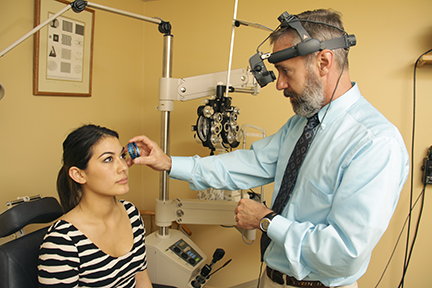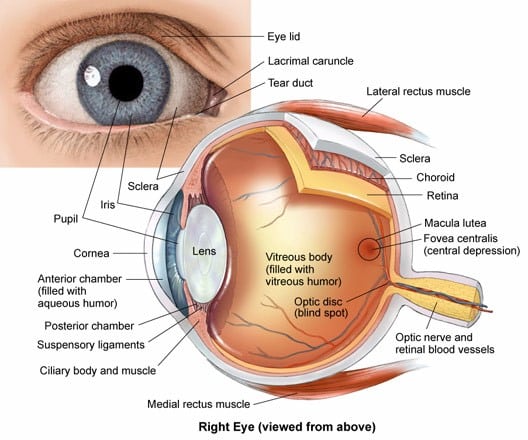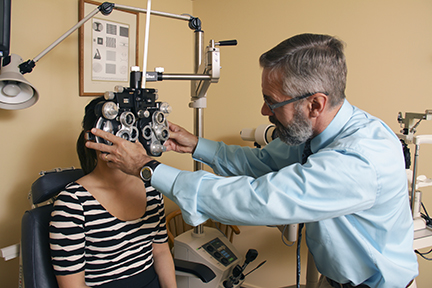At the end of the year, our waitlist for appointments can get long… filled with patients wanting to use insurance benefits and medical savings dollars before they expire. We called a waitlist patient near the end of 2019 – and he was delighted an earlier appointment time came available. He came in to use up his benefits for an annual eye exam and had no specific complaints, just needed more contacts. What started as a routine exam turned into a surgical procedure at a specialist office the same afternoon. We are all very thankful the patient was able to come in sooner than his scheduled appointment.
The patient had not noticed any vision changes, flashes or floaters in his vision and had not experienced any pain but when Dr. McEathron dilated his eyes he saw a slight blood leakage on the patient’s retina. Dr. McEathron sent him directly to Bellingham Retinal Specialists for further evaluation. The same day, the ophthalmologist at the office performed a laser procedure to the patient’s eye to stop the retina hemorrhage and prevent permanent vision loss.
Optometrists can uncover asymptomatic eye problems with potential to become large problems and when they do- it’s quite memorable. Dr. LeClaire recalls a similar event to the one described above when she was practicing in Seattle. “Many people mention in the exam room they do not want to be dilated,” she reflects. “I make sure they understand the benefits of us being able to really see what’s happening in the back of their eyes.”

Routine Physical for your Eyeballs
Dr. LeClaire likes to think of an eye exam as a routine physical for your eyeballs. The doctors discuss eye health and family history to make personalized recommendations to promote long term eye health. Key to creating a great understanding of your eye health is talking about if you experience eye strain and headaches and your daily exposure to electronic devices and computer screens.
Before getting into the physical exam, the doctors will test your vision using the Snellen Chart. See this last blog post for more detail on reading 20/20 and visual acuity measurement.
Your eye movement is studied throughout the exam- how your eyes track and work together. Sometimes a patient who has 20/20 vision but is experiencing headaches, might have delayed focusing or a tracking problem contributing to eye fatigue and strain.
The doctors test your peripheral vision to look for any defects that need further attention. They will also look at your eyelids, eyelashes, tear ducts, blood vessels and iris appearance. When you have this “eyeball physical” done regularly the doctor will record observations and note any variations and the first sign of any issues that could present a long term problem are caught early!

What about the part of the eye you can’t see?
I’ve described the study of how the eyes are moving and the examination of the outside of the eye, but as you can see in the image above- there’s a lot going on under the surface. Two thirds of your eyeball lie below the skin and the best way for the doctor to take a peek at the back of the eye is through that little black hole- your pupil. When the pupil is dilated by the special drops- the doctors can get a much better picture of the back of the eye- the blood vessels and optic nerve.
No, the doctors are not just trying to torture your vision for a few hours- they look at what the back of your eye looks like and create a record of the appearance. Then year after year they will note any changes to these key parts of the eye that work to make you see.
What kind of changes might they be looking for? Well, like for the patient discussed above, blood leakage or tears in the retina can be asymptomatic but when they grow they could lead to permanent vision loss. Abnormal optic nerves could be a sign of glaucoma, which also can lead to permanent vision loss when not treated. Unusual pigmentation on the macula could be an indication of macular degeneration, another eye problem with irreversible vision loss. A brief overview of common eye conditions can be found here.
20/20 Vision for Life!
As you can see, the optometrists performing detailed eye exams do more than measure your ability to read the 20/20 line. The doctors look for any signs of issues that could cause future vision loss. When you schedule an eye exam you will definitely be reading the eye chart, but you’re also taking care of your ability to SEE the eye chart throughout your life. This year of perfect vision we urge you to make eye exams a part of your routine maintenance. Schedule the annual eyeball physical to keep 20/20 vision a reality throughout your life!




